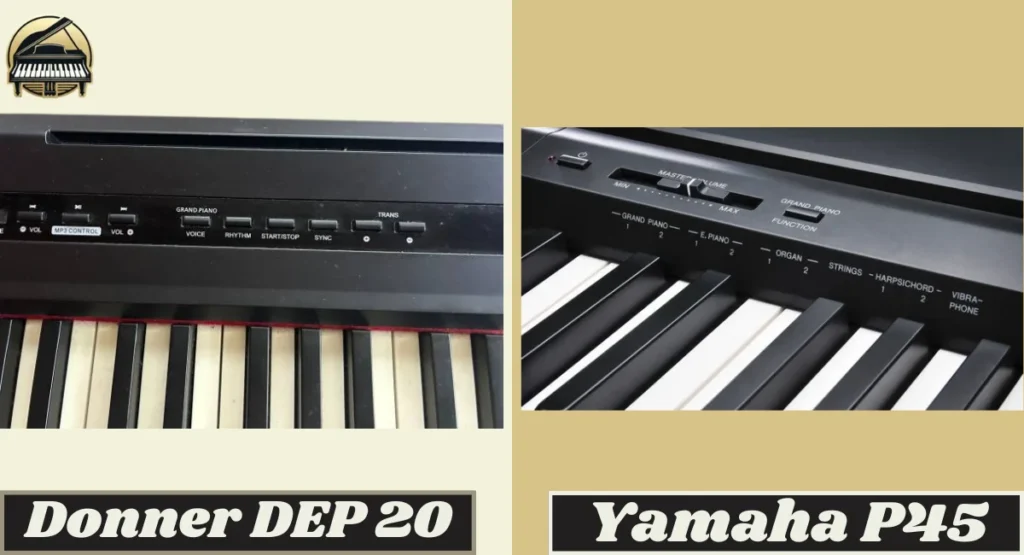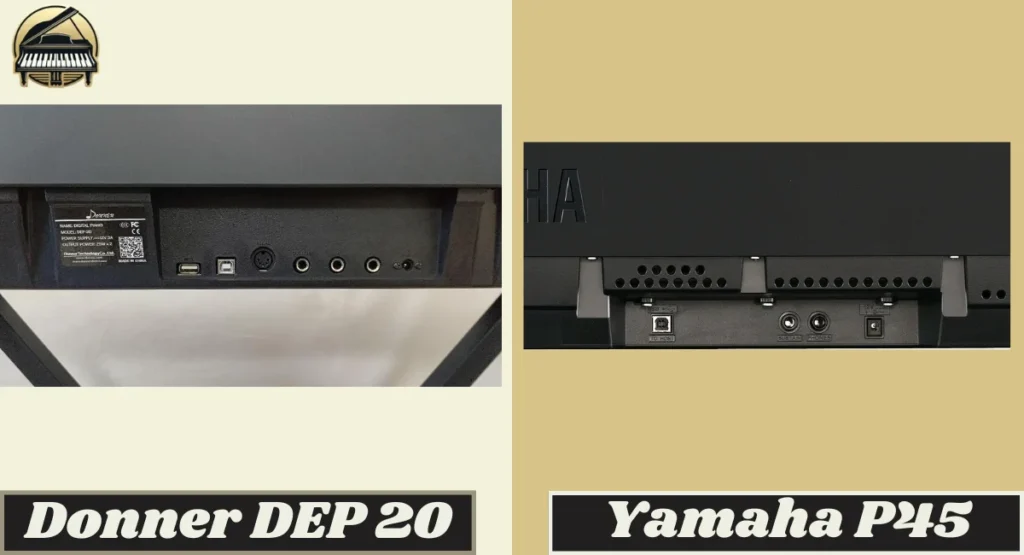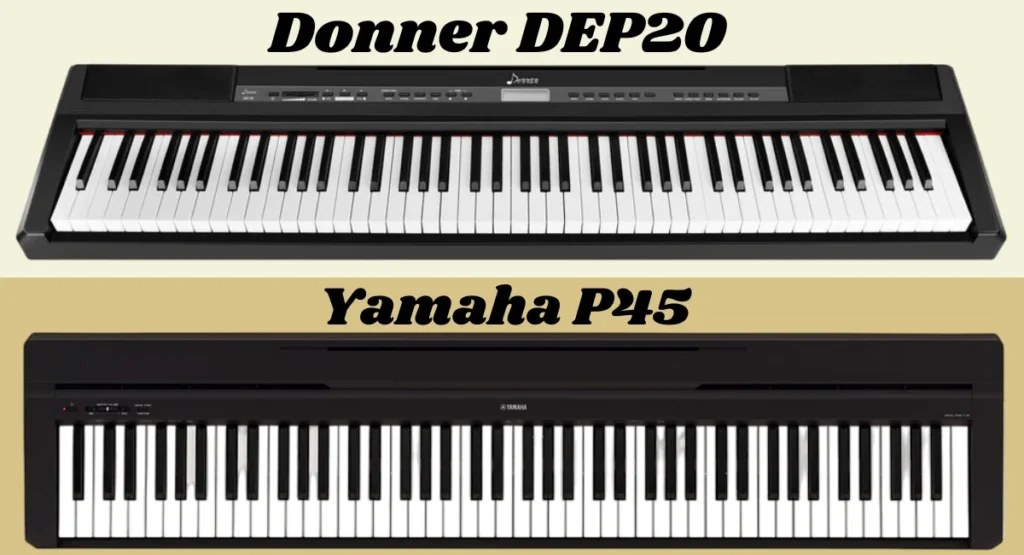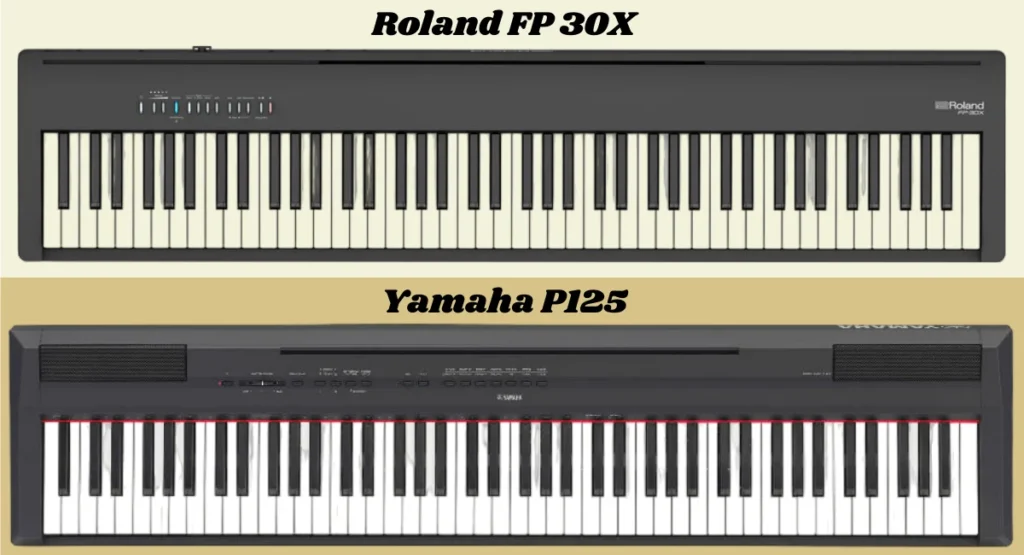Donner DEP20 vs Yamaha P45 are affordable, beginner-friendly, and designed to give you an authentic piano experience without breaking the bank. But when two instruments look similar on paper, how do you know which one is actually better for you?
I remember when I was shopping for my first digital piano. I wanted something that felt like a real piano but didn’t require tuning or take up half the room. I looked at dozens of options, but it always came down to these two. The Yamaha P45 is a trusted name backed by years of craftsmanship, and the Donner DEP20 is a newer brand promising more features for less money.
This comparison will walk you through everything that matters, from sound and key feel to features, connectivity, and long-term value. My goal is to help you determine which piano best suits your playing style, goals, and budget.
By the end of this guide, you’ll have a clear answer to the question every beginner asks: Should you buy the Donner DEP20 or the Yamaha P45?
Table of Contents
Side By Side Comparison Table For Donner DEP20 vs Yamaha P45
| Feature | Donner DEP20 | Yamaha P45 |
|---|---|---|
| Keys | 88 full-size semi-weighted keys | 88 full-size graded hammer keys (GHS) |
| Touch Sensitivity | Adjustable, lighter touch | Authentic graded hammer action |
| Polyphony | 128-note polyphony | 64-note polyphony |
| Built-in Voices | 238 tones (piano, strings, organs, synths) | 10 tones (acoustic and electric pianos, organs, etc.) |
| Speakers | Dual 25W speakers | Dual 6W speakers |
| Display | Backlit LCD screen | No display (simple control interface) |
| Connectivity | USB-MIDI, AUX In/Out, Headphones | USB-to-Host, Headphones |
| Recording Function | Yes (built-in recorder) | No built-in recorder |
| Weight | 12.3 kg (27 lbs) | 11.5 kg (25 lbs) |
| Best For | Creative beginners, casual players | Serious learners, piano students |
| Design Style | Modern digital keyboard looks | Minimal, acoustic-style layout |
| Learning Support | Built-in rhythms, demo songs | Compatible with learning apps |
| Overall Feel | Fun, versatile, and feature-rich | Authentic, focused, and piano-like |
What are the key differences between the Donner DEP20 and the Yamaha P45?
The Yamaha P45 focuses on authentic piano sound and realistic key feel. It’s designed for players who want to practice and perform with a sound that feels close to an acoustic piano.
The Donner DEP20 offers more sounds, settings, and creative options. It’s made for beginners who want to explore different tones and styles while still having the full 88-key range to learn properly.
Here’s how they really differ in practice:
- Tone Philosophy: Yamaha goes for realism; Donner focuses on variety and fun.
- Key Feel: The P45’s GHS weighted keys feel heavier and more natural, while the DEP20’s semi-weighted keys are lighter and easier for absolute beginners.
- Sound Options: Donner gives you hundreds of built-in tones; Yamaha keeps it simple with 10 carefully sampled instruments.
- Learning Tools: Donner includes a recording function, a metronome, and a dual keyboard mode, handy for students and teachers.
- Build and Brand Reputation: Yamaha is an established, trusted name in digital pianos. Donner is newer but quickly gaining traction for its value-focused products.
If you’re serious about developing your piano technique, the Yamaha P45 might give you a more realistic experience.
If you’re still exploring or want an instrument that encourages creativity and experimentation, the Donner DEP20 offers more flexibility for the price.
What are the main specifications and features of Donner DEP20 vs Yamaha P45?
Both of these pianos target beginners and hobbyists, but their technical specs show that they were built with slightly different goals in mind. Let’s look at what each one offers in detail.
Yamaha P45: Simplicity and Authentic Feel
Yamaha has a long history of crafting instruments that sound and feel natural, and the P45 is a great example of that. It’s one of the simplest models in their lineup, but it does the essentials very well.
- 88 fully weighted keys with Graded Hammer Standard (GHS) action, heavier on the low end, lighter on the high end.
- AWM Stereo Sampling for a rich, acoustic-style piano sound.
- 64-note polyphony, which prevents sound cut-offs during sustained or layered notes.
- 10 instrument voices, including acoustic and electric pianos, organs, and strings.
- USB to Host for MIDI connectivity and headphone jack for silent practice.
- Slim, minimalist design that fits easily in small spaces.
- Weight: Around 11.5 kg, easy to move or set up.
This piano keeps things simple but refined. You won’t get dozens of tones or fancy settings, but what you do get is authenticity and reliability.
Donner DEP20: Versatile and Feature-Packed
The Donner DEP20 takes a different approach. It’s built for learners who want a bit of everything: piano, keyboard, and workstation in one package.
- 88 semi-weighted keys with adjustable touch sensitivity are easier to play for long sessions.
- 238 instrument tones and 200 rhythms, offering everything from strings to synths.
- 128-note polyphony, great for layering and complex passages.
- Built-in recording and playback to help you practice and track progress.
- Dual keyboard and split modes, perfect for duets or teacher-student setups.
- Small LCD screen that makes navigation much easier than Yamaha’s minimalist buttons.
- Weight: Around 12.3 kg, still portable and classroom-friendly.
While it doesn’t feel quite as natural under the fingers as the Yamaha, the DEP20 gives you far more room to explore different styles of music. It’s a fun, flexible choice if you like experimenting with sounds beyond classical piano.
How Do The Donner DEP20 vs Yamaha P45 Compare In Terms Of Design and Build?
When you first look at these two pianos side by side, it’s clear they’re built with different players in mind.
- The Yamaha P45 keeps things simple and traditional, with clean lines, a smooth matte finish, and just enough buttons to get the job done.
- The Donner DEP20, meanwhile, has a more “digital workstation” look, featuring an LCD screen and a few extra controls that invite exploration.
If you prefer something that looks timeless and blends naturally into your space, Yamaha’s design will probably appeal more.
But if you like having features right at your fingertips, Donner’s layout makes experimenting easier.
What Are the Dimensions and Weight of Each Piano?
If space is tight or you move your piano often, size and weight matter more than most people think.
- Yamaha P45: About 52 inches wide, 11.5 inches deep, and 6 inches high. It weighs roughly 11.5 kg (25 lbs), which makes it easy to lift, set up, or store. It’s perfect for smaller rooms, home studios, or anyone who needs to take their piano to lessons or gigs.
- Donner DEP20: Slightly larger at 52 inches wide, 13 inches deep, and 6 inches high, and about 12.3 kg (27 lbs). That extra bulk comes from its built-in LCD screen and speaker system, which give it more functionality but a bit less portability.
In day-to-day use, both are still manageable. The Yamaha feels lighter and easier to handle, while the Donner gives you a few extra tools without being overly heavy.
If you’re planning to keep your piano in one place, you’ll hardly notice the difference.
How Does the Key Action Feel on Each Model?

This is where you start to feel the real difference between the two.
If you’ve played an acoustic piano before, the Yamaha P45 will feel immediately familiar.
Its Graded Hammer Standard (GHS) keys get heavier in the lower range and lighter in the higher range, just like a real upright or grand.
That realistic resistance helps you build proper finger control and technique — something you’ll appreciate if you’re serious about learning or already used to acoustic playing.
The Donner DEP20 uses semi-weighted keys, which are noticeably lighter. They respond quickly and don’t require as much force, making long practice sessions a bit easier on the hands.
If you’re a beginner or mostly play pop, worship, or electronic styles, this lighter feel can be a plus.
In short:
- Choose the Yamaha P45 if you want the most authentic, piano-like touch.
- Consider the Donner DEP20 if comfort and ease of play are your top priorities right now.
Which Piano Is More Portable and Visually Appealing?
Both instruments are compact and practical, but they cater to different tastes.
Yamaha P45: Simple, elegant, and understated. It looks good in any room and doesn’t draw too much attention, the kind of design that quietly fits into your home or studio. Its slim frame and light weight make it easy to carry or set up anywhere.
Donner DEP20: A little larger but more “digital” in appearance. The LCD screen, extra buttons, and speaker design make it feel more interactive. If you enjoy seeing visual feedback and switching sounds often, you’ll probably like this style.
If you like a classic, acoustic-inspired look, Yamaha wins.
If you prefer a modern digital setup with more hands-on control, Donner has the edge.
Which Digital Piano Sounds Better?
Sound is where a digital piano really earns your attention. Even if the keys feel right, the tone underneath has to inspire you to keep playing. The Donner DEP20 and Yamaha P45 both sound good for their price, but they approach sound in completely different ways; one focuses on realism, while the other leans toward variety.
What Built-In Voices and Piano Tones Donner DEP20 vs Yamaha P45 Offer?
The Yamaha P45 keeps things simple with 10 core voices, including acoustic piano, electric piano, strings, organs, and a few others. What stands out is the main piano tone, sampled from Yamaha’s acoustic grand. It’s clean, warm, and balanced, with that familiar Yamaha clarity that works well for classical, jazz, or pop. It’s not overloaded with effects or layers; it just sounds natural and consistent.
The Donner DEP20, meanwhile, gives you 238 tones, covering everything from grand piano and harpsichord to synths, basses, and percussion. It’s a playground if you like experimenting. Some of the tones sound digital and bright, but the variety is impressive for this price range. You can switch moods quickly; one moment you’re playing a soft ballad, and the next you’re layering pads under your melody.
If you like exploring different sounds and styles, Donner’s tone library keeps things interesting. If you want one great piano sound that feels close to the real thing, Yamaha’s focus on quality over quantity makes more sense.
How Does Polyphony and Layering Affect the Sound?
Polyphony tells you how many notes the piano can play at once, and it makes a big difference if you use sustain or play complex pieces.
The Yamaha P45 offers 64-note polyphony, which is enough for most songs, even with layered notes or pedal use. You won’t hear notes cutting out during normal playing. For advanced compositions or heavy layering, it’s not huge, but it holds up solidly for its category.
The Donner DEP20 doubles that with 128-note polyphony, which gives you more breathing room. You can layer sounds, like strings over piano, and sustain chords without losing notes. It’s especially handy if you like using multiple voices or playing with the dual-mode function.
For purists, Yamaha’s realism matters more than numbers. But if you enjoy layering sounds and experimenting, Donner’s extra polyphony gives you freedom to play without limits.
How Good Are the Speakers and Output options of Donner DEP20 vs Yamaha P45?
Built-in speakers are often overlooked, but they shape your first impression of how a piano “feels” to play.
The Yamaha P45 comes with two 6-watt speakers. They’re modest but balanced, offering a clear, natural sound that fills a small room nicely. If you connect headphones or an external amp, the tone becomes even richer, which many players prefer for recording or performing.
The Donner DEP20 uses two 25-watt speakers, and you can hear the difference immediately. It’s louder, fuller, and great for group sessions or small performances. The sound leans a bit brighter and more digital, but for its price, it delivers a powerful, enjoyable tone. It also offers multiple outputs, making it easy to connect to mixers, amps, or recording setups.
If you mostly play at home or use headphones, the Yamaha’s sound balance feels smoother. If you like a more energetic sound that can fill a room, Donner’s stronger speakers are hard to beat.
Donner DEP20 vs Yamaha P45: Which Model Offers a More Realistic Playing Experience?
If your goal is to get as close as possible to the sound of a real piano, the Yamaha P45 is the one that delivers that depth. Its sampling feels organic, notes resonate naturally, and there’s a warmth that connects well with expressive playing.
The Donner DEP20 sounds brighter and more synthetic, but it makes up for it with flexibility. It’s fun, versatile, and works well if you enjoy different genres or want a more creative setup.
So, if you’re chasing realism, go for the Yamaha P45.
If you like variety, layers, and the excitement of switching sounds, the Donner DEP20 gives you more to explore.
Which Piano Features and Functions Offer More Value?
When you start comparing features, the Donner DEP20 and Yamaha P45 cater to two different kinds of players. Yamaha keeps things simple; it’s built for those who just want to focus on playing. Donner adds more tools, effects, and options that appeal to people who like experimenting or recording their own music.
What Connectivity Options Are Available In Donner DEP20 vs Yamaha P45 (USB, MIDI, Headphones)?

Connectivity might not seem like a big deal at first, but it really affects how you use your piano over time, especially if you like learning through apps, recording music, or connecting to speakers.
- Yamaha P45: You get a USB-to-Host connection that lets you link the piano to a computer, tablet, or learning app like Flowkey or Simply Piano. It’s simple, stable, and perfect if you just need MIDI support for practice or light recording.
- Donner DEP20: Offers a wider range of options, USB-MIDI, AUX In/Out, and headphone jacks. That means you can connect external speakers, plug in headphones for quiet practice, or link it to other sound equipment. It’s a nice touch if you like having a bit more flexibility with your setup.
If you mainly play at home, Yamaha’s connection is all you’ll need. But if you enjoy creating or performing, Donner’s ports make your setup more versatile.
Which Built-In Features, Like Lessons, Metronome, or Demo Songs, Are Included?
Here’s where you’ll notice the biggest difference in approach.
Yamaha P45 keeps it minimal but effective. You’ll find a built-in metronome, dual voice mode for layering two sounds, and simple reverb settings to add depth to your tone. There are no onboard lessons or demo songs. Yamaha’s philosophy is to give you the essentials for focused practice and performance.
Donner DEP20, meanwhile, packs in plenty of extras. You get demo songs, built-in rhythms, and split mode so you can play bass on one side and melody on the other. It’s more interactive, especially for beginners who enjoy learning by exploring.
If you prefer a clean, distraction-free piano experience, Yamaha’s simplicity feels refreshing. But if you like discovering new sounds or playing along with rhythms, Donner keeps things fun and engaging.
Can You Record and Playback Music on Each Piano?
Recording can be incredibly useful whether you’re tracking progress, composing, or just hearing yourself play.
- Yamaha P45: Unfortunately, it doesn’t include built-in recording. You’ll need to connect it to a computer or tablet if you want to record MIDI or audio.
- Donner DEP20: Includes an internal recording feature, so you can record and play back your music right from the keyboard. It’s simple to use and great for practice sessions or songwriting ideas.
If you like reviewing your performances or creating your own music, Donner gives you that ability out of the box. If you prefer a cleaner interface and plan to record through software anyway, Yamaha’s simpler design won’t bother you.
Is the Yamaha P45 better for beginners than the Donner DEP20?
If you’re just starting your piano journey, both models can work well, but they serve different learning styles.
The Yamaha P45 is perfect if you want to focus on technique and develop a feel that’s close to an acoustic piano. It’s weighted keys teach you proper finger strength and control early on, which pays off later when you move to acoustic instruments. The layout is clean, so you can focus on playing rather than navigating menus.
The Donner DEP20 gives beginners a more playful start. It comes with built-in demo songs, rhythms, and lesson modes that make practice sessions feel interactive. If you’re the type who learns better when things are fun and varied, you’ll probably enjoy it more.
In short:
- Choose Yamaha P45 if you want an authentic feel and simplicity.
- Choose Donner DEP20 if you want more features and guided practice tools.
How Reliable and Durable Are These Digital Pianos?
The P45 has been around for years, and it’s known for solid construction and consistent performance. The key action holds up well over time, even with regular use. Plus, Yamaha’s after-sales service is dependable; you can find help or parts easily in most countries.
Donner has improved in recent years, but it’s still a newer player in the digital piano space. The DEP20 feels sturdy for its price, though it doesn’t have the same long-term reputation as Yamaha. For casual use or as a first digital piano, it’s a great value. But if you’re planning to practice daily for years, Yamaha’s durability gives you more peace of mind.
Is the Price Difference Justified In Donner DEP20 vs Yamaha P45?
This is the question most people ask, and it’s fair. The Donner DEP20 often costs noticeably less than the Yamaha P45, but that doesn’t automatically make it the better deal.
With Yamaha, you’re paying for proven sound quality, realistic touch, and long-term reliability. It’s a “buy once, use for years” instrument. Donner, meanwhile, gives you tons of features for less money, hundreds of voices, recording, and rhythm options. But some of that budget goes toward features instead of premium build or sound.
Think of it this way:
- The Yamaha P45 is for those who value feel and longevity.
- Donner DEP20 is for those who want the most fun and functionality for the price.
Which One Should You Buy for Home or Stage Use?
If your main goal is to practice or learn at home, both pianos are great. The Donner DEP20 offers a fuller range of tones and the ability to connect to external speakers, making it fun for home jam sessions. It’s also a bit louder out of the box, thanks to its built-in speaker setup.
For stage or performance use, the Yamaha P45 feels more dependable. It’s lighter, cleaner-looking, and connects easily to amps or PA systems. The key action and piano tone also translate better in live environments, giving a more authentic acoustic sound under pressure.
So here’s a simple breakdown:
- For home practice and creativity: Donner DEP20.
- For serious play or live performance: Yamaha P45.
What Are The Pros And Cons Of Donner DEP20 vs Yamaha P45?
Yamaha P45
Pros
Realistic key action
Authentic piano tone
Lightweight design
Easy to use
Reliable build quality
Great for beginners
Trusted brand reputation
Cons
Limited features
Few sound options
No recording function
Donner DEP20
Pros
Budget-friendly price
Many sound options
Built-in recording
Dual speaker setup
Split and layer modes
Bright LCD screen
Great connectivity ports
Cons
Semi-weighted keys
Slightly bulky design
Average piano tone
Final Verdict: Which Piano Should You Choose?
Donner DEP20 vs Yamaha P45 stand out as excellent entry-level digital pianos, but they serve slightly different types of players.
If your goal is to learn proper technique and experience something that feels close to a real acoustic piano, the Yamaha P45 is the better long-term investment. Its graded hammer action builds real playing strength and control, and its clean, uncluttered layout keeps you focused on music, not settings. It’s the kind of instrument teachers trust because it helps you develop the right touch from the start.
The Donner DEP20 shines for players who want variety and creativity. With hundreds of tones, built-in rhythms, and recording features, it’s more than a practice tool; It’s a small studio in one keyboard. It might not feel quite as “piano-like” as the Yamaha, but it’s a lot of fun to explore and offers incredible value for the price.
So, if you’re someone who says, “I just want a piano that feels real and helps me grow,” go for the Yamaha P45.
If you think, “I want more sounds, more flexibility, and more fun,” the Donner DEP20 won’t disappoint.
In the end, it’s not just about specs, it’s about what inspires you to play more often. Pick the one that fits your goals, your space, and the way you enjoy making music.
Frequently Asked Questions
Is the Donner DEP20 better for beginners than the Yamaha P45?
Both are beginner-friendly, but they serve different needs. The Yamaha P45 is ideal if you want to learn proper piano technique with weighted keys. The Donner DEP20 suits beginners who enjoy experimenting with sounds and features.
Which digital piano has a more realistic key feel?
The Yamaha P45 feels more authentic thanks to its Graded Hammer Standard (GHS) keys. The Donner DEP20 uses semi-weighted keys, which are lighter and easier to press but not as close to an acoustic piano.
Can I record my music on these pianos?
Yes, but only the Donner DEP20 offers a built-in recording function. The Yamaha P45 does not have this feature, though you can connect it to a computer or app to record digitally.
Which piano has more sound options and tones?
The Donner DEP20 clearly wins here. It includes over 200 voices, while the Yamaha P45 offers only 10 core sounds, focusing on realism over variety.
Does either piano support Bluetooth?
Neither the Donner DEP20 nor the Yamaha P45 has built-in Bluetooth. However, you can connect Bluetooth adapters to their USB or MIDI ports for wireless control or app integration.
In Donner DEP20 vs Yamaha P45, Which model is better for live performances?
If portability and simplicity matter most, the Yamaha P45 is easier to move and set up. But if you want more sound control and layering options during performances, the Donner DEP20 gives you more flexibility
How loud are the built-in speakers?
Both have good speaker systems for home use. The Donner DEP20’s dual 25W speakers are slightly more powerful, while the Yamaha P45’s sound is cleaner and more balanced.
Can I use headphones with these pianos?
Yes, both models have headphone jacks, allowing silent practice without disturbing others. It’s one of the most useful features for home practice.
Which one is easier to use for daily practice?
The Yamaha P45 wins for simplicity; just turn it on and play. The Donner DEP20 has more buttons and menus, which take a little time to get used to but offer more creative control once you do.



